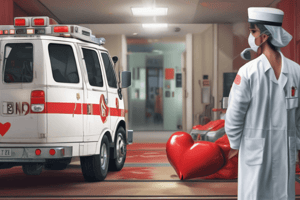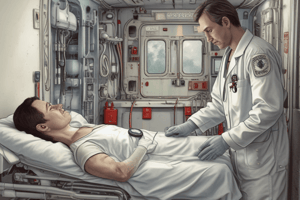Podcast
Questions and Answers
Which of the following would be the MOST compelling reason to disagree with a patient's refusal of transport after experiencing a seizure?
Which of the following would be the MOST compelling reason to disagree with a patient's refusal of transport after experiencing a seizure?
- He is young and healthy
- He has no prior history of seizures
- He is currently not prescribed any medications (correct)
- He is conscious and answering questions appropriately
A patient who is possibly experiencing a stroke is NOT eligible for thrombolytic therapy if he or she:
A patient who is possibly experiencing a stroke is NOT eligible for thrombolytic therapy if he or she:
- Has high blood pressure
- Has a history of strokes
- Has bleeding within the brain (correct)
- Is younger than 18
What does a patient with slurred speech likely experience?
What does a patient with slurred speech likely experience?
Dysarthria
What does altered mental status indicate?
What does altered mental status indicate?
During the primary assessment of a semiconscious patient, what should you ensure?
During the primary assessment of a semiconscious patient, what should you ensure?
What signs are considered early indications of increased intracranial pressure?
What signs are considered early indications of increased intracranial pressure?
What condition can mimic symptoms of hypoglycemia?
What condition can mimic symptoms of hypoglycemia?
Interruption of cerebral blood flow may result from all of the following, EXCEPT:
Interruption of cerebral blood flow may result from all of the following, EXCEPT:
What do patients with a subarachnoid hemorrhage typically complain of?
What do patients with a subarachnoid hemorrhage typically complain of?
What does the left cerebral hemisphere control?
What does the left cerebral hemisphere control?
What is the MOST significant risk factor for a hemorrhagic stroke?
What is the MOST significant risk factor for a hemorrhagic stroke?
What is a principal difference between a patient who has had a stroke and a patient with hypoglycemia?
What is a principal difference between a patient who has had a stroke and a patient with hypoglycemia?
What are the three major parts of the brain?
What are the three major parts of the brain?
When assessing arm drift of a suspected stroke patient, what should you ask the patient to do?
When assessing arm drift of a suspected stroke patient, what should you ask the patient to do?
What results when blood flow to a part of the brain is cut off by a blockage inside a blood vessel?
What results when blood flow to a part of the brain is cut off by a blockage inside a blood vessel?
What should you be MOST alert for when caring for a patient with documented hypoglycemia?
What should you be MOST alert for when caring for a patient with documented hypoglycemia?
What is the MOST important information to determine when obtaining medical history from the family of a suspected stroke patient?
What is the MOST important information to determine when obtaining medical history from the family of a suspected stroke patient?
Which of the following conditions would be the LEAST likely to mimic the signs and symptoms of a stroke?
Which of the following conditions would be the LEAST likely to mimic the signs and symptoms of a stroke?
Which condition would MOST likely affect the entire brain?
Which condition would MOST likely affect the entire brain?
Which of the following MOST accurately describes a simple partial seizure?
Which of the following MOST accurately describes a simple partial seizure?
Which of the following MOST accurately describes what the patient will experience during the postictal state that follows a seizure?
Which of the following MOST accurately describes what the patient will experience during the postictal state that follows a seizure?
Which of the following symptoms would lead you to believe that a patient's headache is caused by sinus congestion?
Which of the following symptoms would lead you to believe that a patient's headache is caused by sinus congestion?
If a patient with slurred speech has a history of TIAs and hypertension, which area of the brain is likely affected?
If a patient with slurred speech has a history of TIAs and hypertension, which area of the brain is likely affected?
What should treatment for a patient with sudden onset of left-sided paralysis include?
What should treatment for a patient with sudden onset of left-sided paralysis include?
What should you do for a child experiencing a seizure after a high fever?
What should you do for a child experiencing a seizure after a high fever?
What Glasgow Coma Scale score should be assigned if a patient opens his eyes, moans, and pulls away when you pinch his trapezius muscle?
What Glasgow Coma Scale score should be assigned if a patient opens his eyes, moans, and pulls away when you pinch his trapezius muscle?
Flashcards are hidden until you start studying
Study Notes
Seizures
- A generalized (tonic-clonic) seizure may lead to refusal of transport, especially if the patient is not on any medications.
- Confusion and fatigue are common in the postictal state after a seizure.
- A simple partial seizure originates in one extremity.
Stroke and Related Conditions
- Thrombolytic therapy is contraindicated in patients with bleeding within the brain.
- Conditions mimicking stroke symptoms include hypoglycemia, which can lead to altered mental status.
- Sudden severe headaches are typical complaints in subarachnoid hemorrhage.
- Mental status differentiation is crucial between stroke and hypoglycemia patients.
- Symptoms like slurred speech indicate dysarthria.
Brain Function and Health Risks
- The left cerebral hemisphere governs the right side of the body.
- Hypertension is the most significant risk factor for hemorrhagic strokes.
- An ischemic stroke occurs when blood flow to the brain is blocked.
- Key brain components include the cerebrum, cerebellum, and brain stem.
- Respiratory failure or cardiopulmonary arrest can impact the entire brain.
Patient Assessment
- During arm drift assessment for stroke, ask the patient to close their eyes.
- Assessing when the patient last appeared normal is essential for emergency care.
- Symptoms that worsen when bending over may indicate sinus congestion.
Specific Case Management
- For a semiconscious patient, ensure airway patency and support ventilation.
- Positioning in recovery is critical for stroke patients with stable respiratory status.
- After finding a patient with slurred speech and a history of TIAs, the left hemisphere is likely affected.
Pediatric Considerations
- In the case of a seizing child with a high fever, transport to the hospital while reassuring the family is necessary.
Glasgow Coma Scale (GCS)
- A patient who opens eyes, moans, and withdraws from a painful stimulus would have a GCS score of 8.
Studying That Suits You
Use AI to generate personalized quizzes and flashcards to suit your learning preferences.



